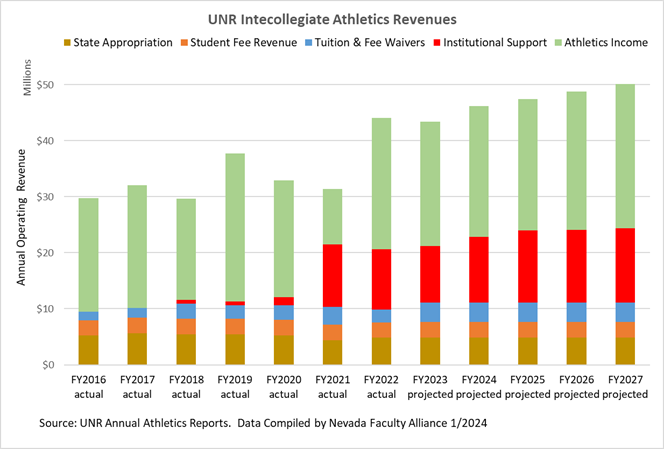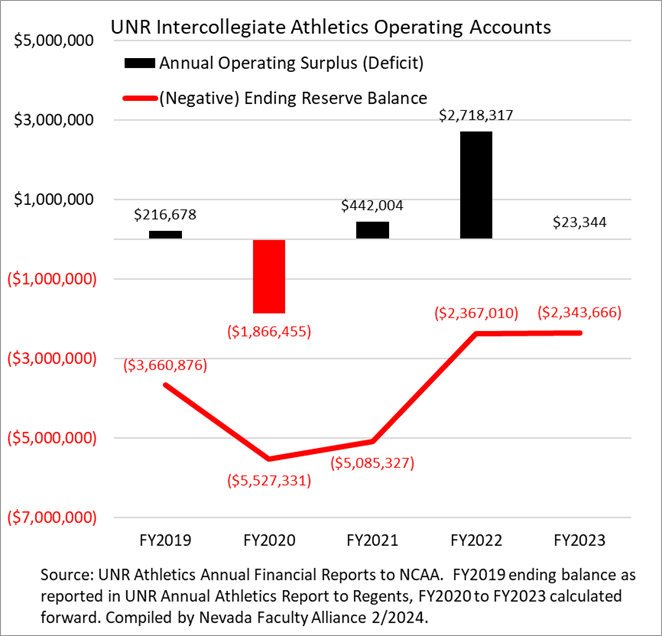UNR Budget: Misplaced Priorities and Diverted Resources
Part 2. $10+ Million Increase in University Support for Intercollegiate Athletics
This is the second article in a series of analyses of the UNR budget situation.
Here we take a deeper dive into the diversion of resources away from the core academic mission by the UNR administration. In August 2023, the Nevada Sports Network reported that UNR is boosting institutional support of Intercollegiate Athletics by $10 million per year, funds that presumably could be spent on instructional operations. Unfortunately, we cannot yet answer the question about the exact source of the extra $10 million per year in university support of Athletics [1]. Spoiler alert: it could be from student registration fees.
Athletics budget data are obtained from the UNR Annual Athletics Reports submitted to the Board of Regents for 2019-20, 2020-21, and 2021-2022 [2].
UNR institutional support for Athletics was zero in FY2016 and FY2017. In FY2018 and FY2019, $650,000 each year was provided in Cost of Attendance Funds (financial aid for student-athletes beyond fees and tuition). In FY2020, that went up to $1,425,000, adding “COLA and fringe assistance.”
In response to the pandemic, UNR added $10 million in institutional support to offset the revenue losses for Athletics in FY2021, for a total institutional support of $11.1 million. Those funds were likely from federal Higher Education Emergency Relief Funds granted through the American Rescue Plan Act, although the UNR Annual Athletics Report does not indicate the source.
UNLV also increased institutional support for Athletics in FY2021, by $7.5 million from COVID relief funds according to the UNLV Annual Athletics Report. For future years, however, UNLV is returning to pre-pandemic institutional support levels. In contrast, UNR continued the increased institutional support for FY2022, at $10.7 million.
UNR Athletics budget projections include institutional support of $10.1 million in FY2023, $11.7 million in FY2024, $12.9 million in FY2025, and $13.0 million in FY2026. The chart below shows actual and projected revenues for UNR Intercollegiate Athletics for FY2016 through FY2027, obtained from the Annual Athletics Reports provided to the Board of Regents for 2019-20, 2020-21, and 2021-2022. “Athletics Income” represents all the revenue internally generated by Athletics including ticket sales, dedicated gifts, and media and conference income; the remainder is from state appropriations, student fees, waived tuition and fees, and institutional support. Institutional support was a tiny fraction of the UNR Athletics budget prior to 2020; now it is about 30% of the budget. Internal Athletics income now covers only about 50% of the expenditures: the remainder is from state appropriations, student fees, tuition and fee waivers, and institutional support. The combined state, student, and institutional subsidies for UNR Athletics are projected to be nearly $23 million for FY2024.

The addition of $10 million in university subsidies to Athletics represents a 26.4% increase over the pre-pandemic actual total revenue of $37.8 million for FY2019, which was an especially good year for Athletics income. It doubles the total subsidy from the state, university, and students. Although Athletics is subject to a $830,000 reduction for FY2024 as part of the 5% “across-the-board” cuts to university programs, that is offset by an increase in the state appropriation to $5,580,806 from the projected budget of $4,835,440, an increase of $745,366. A $830,000 cut would be 5% of a budget of $16,600,000; it is not clear to which portion of the projected FY2024 $46.1 million total Athletics revenue that applies.
Where does the extra $10 million to $13 million per year in UNR institutional support to Athletics come from for FY2023 and beyond? Federal COVID relief funds are no longer available. It is not from direct state appropriations ($4.8 million/year) or the student per-credit fees specifically for athletics ($2.8 million/year or $6/credit), which are reported separately, as are gifts designated for Athletics ($3.0 million per year including season ticket sales). The UNR Foundation has provided capital improvement funds for Athletics facilities; unrestricted foundation funds could also be used for support of Athletics operations–the 2022-2023 UNR Foundation Annual Report lists $2.4 million in program gifts identifiable as athletics-related.
The 2022 legislative audit [3] of NSHE self-supported programs for FY 2018 through FY2021 faulted two NSHE institutions, presumably UNR and UNLV, for using restricted student fee funds to support athletics: "Specifically, two institutions used a total of nearly $6.7 million in general improvement and other restricted student fees to support athletics and band programs over several years" [3]. However, the institutions argued that support for athletics was an allowed use.
Our understanding is therefore that the institutional support funds for Athletics could be derived from per-credit student registration fees in the General Improvement, Activities & Programs, or Student Access budget categories. That is, student support for Athletics could be significantly greater than is reported as “student fee revenue” in the Annual Athletics Reports. There may be other unrestricted discretionary funds available that have not been disclosed as the source, including continuing royalty income from UNR’s Marigold Mine stake and investment income from the NSHE Operating Pool. Regardless of the exact source of funding [1], the Sandoval administration is diverting an extra $10 million/year or more to Athletics on an ongoing basis that could be used for core academic programs to serve all students (or for financial aid in the case of Student Access fees). Each $1 million diverted from the core instructional budget is equivalent to about 10 new academic faculty hires [4].
[Update 2/2/2024: UNR Intercollegiate Athletic's annual financial statements to NCAA are submitted in mid-January for the prior fiscal year. The following chart shows the annual operating surplus or deficit reported to NCAA from FY2019 through FY2023, along with the (negative) ending reserve balances (as reported in UNR's Annual Athletics Report for FY2019 and calculated forward). The additional $10 million/year in University support started in FY2021. With this extra operating revenue, UNR Athletics about broke even in FY2021 and FY2023 and had a $2.7 million operating surplus in FY2022. In other words, most of the $10 million annually is being spent.]

###
The information in this series of analyses of the UNR budget is based on public reports and records, interpreted as accurately as possible given uncertainties in the assumptions used for various reports. Corrections from authoritative sources are welcome. Contact: kent.ervin@nevadafacultyalliance.org.
___________
[1] Public records requests were submitted to UNR in December 2023 to determine how General Improvement student fees, Activities & Programs student fees, and Marigold Mine royalty income are being distributed. An update will be provided when available.
[2] The Annual Athletics Reports from UNR and UNLV to the Board of Regents present budget data in two forms. The NCAA Annual Statements of Revenues and Expenditures include various non-cash contributions that are not included in the internal Workday budget data. “Direct Institutional Support” as reported to NCAA includes tuition and fee waivers in addition to the “Institutional Revenue” reported to the Board of Regents for budget reports. Tuition and fee waivers represent lost revenue to the university instructional budget, but arguably some would not be realized if fewer student-athletes were attracted to the program. Here we use “institutional support” to mean the cash portion of direct institutional support and use the internal reports of total revenue and expenditures.
[3] Performance Audit, Nevada System of Higher Education Self-Supporting and Reserve Accounts, Legislative Auditor, 2022.
[4] A UNR Assistant Professor hired at Q1 on the current salary schedule would earn $69,383. Adding the 33.8% fringe rate gives $92,834, or 10.8 positions per million dollars. By the Board of Regents action on December 1, 2023, the salary schedules will be augmented by 10% as of July 1, 2024, giving 9.8 positions per million dollars for future new hires.
Articles in this series:
Updated 1/18/2024 in include information from the 2022 Legislative Audit of NSHE.
Update 2/2/2024 to include information on annual operating surpluses and deficits and negative reserve balances.